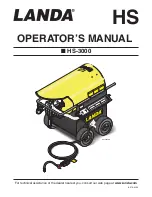
11
Operations
Tire Pressure
Proper air pressure for your tires is printed on the
sidewall. Check pressure while tires are cold. Do not
raise or lower pressure to meet load. Pressure other
than recommended pressure will lead to excessive tire
wear or tire failure.
Balancing recommended.
Wheels
Check wheels for hole
elongation or “out of round”.
This condition can be caused by
lug nuts not being tight or being
too tight. Trailer wheels can be
damaged by chuck holes or
curb jumping. You may not be
aware of the road shock to the wheels without periodic
checks. Replace any wheel that is bent. Replace any
wheel if you see elongation of the bolt holes.
Wheel Lugs
Wheel lug nuts must be tightened with a torque wrench.
Refer to the chart below for proper torque.
1.
Start all bolts or nuts by hand to prevent cross
threading.
2.
Tighten bolts or nuts following sequence at right.
3.
The tightening of the fasteners should be done in
stages. Following the recommended sequence,
tighten fasteners per wheel torque chart below.
4.
Wheel nuts/bolts should be torqued before first
road use and after each wheel removal. Check and
re-torque after the first 10 miles, 25 miles and
again at 50 miles. Check periodically thereafter.
Ball Coupler Hitches
Coupler assembly includes a latch lever and latch lever
safety pin or hitch pin. Be sure the latch lever is locked
and the pin properly secured before moving your trailer.
The pin can be engaged fully only if ball is properly
seated in the coupler.
Tires
Before mounting tires onto wheels make certain that
the rim size and contour is approved for the tire as
shown in the Tire and Rim Association Yearbook or the
tire manufacturer’s catalog. Also make sure the tire will
carry the rated load. If the load is not equal on all tires
due to trailer weight distribution, use the tire rated for
the heaviest wheel position.
Note: The capacity rating molded into the sidewall of
the tire is not always the proper rating for the tire if used
in a trailer application. Use the following guideline:
1.
LT and ST tires: use the capacity rating molded into
the tire.
2.
Passenger Car Tires: Use the capacity rating
molded into the tire sidewall divided by 1.10.
Use tire mounting procedures as outlined by the
Rubber Manufacturer’s Association or the tire manufac-
turers.
NOTE: Tire wear should be checked frequently
because once a wear pattern becomes firmly
established in a tire it is difficult to stop, even if the
underlying cause is corrected.
Wheel Torque Requirements
Wheel Size
Torque Sequence
1st Stage
2nd Stage
3rd Stage
15”
20-25
50-60
80-90
1
2
3
4
5
WEAR PATTERN
CAUSE
ACTION
ACTION
Center
Wear
Over
Inflation
Adjust pressure
to particular
load per tire
catalog.
Edge
Wear
Under
Inflation
Adjust pressure
to particular
load per tire
catalog.
Side Wear
Loss of
camber or
overloading
Make sure load
doesn't exceed
axle rating.
Align at
alignment shop.
Toe Wear
Incorrect
toe-in
Align at
alignment shop.
Cupping
Out of
balance
Check bearing
adjustment and
balance tires.
Flat
Spots
Wheel
lockup & tire
skidding
Avoid sudden
stops when
possible and
adjust brakes.
KÄRCHER TRAILER OPERATORS MANUAL • 9.807-794.0-B
Summary of Contents for 1.103-843.0
Page 26: ...9 807 794 0 Printed in U S A ...












































